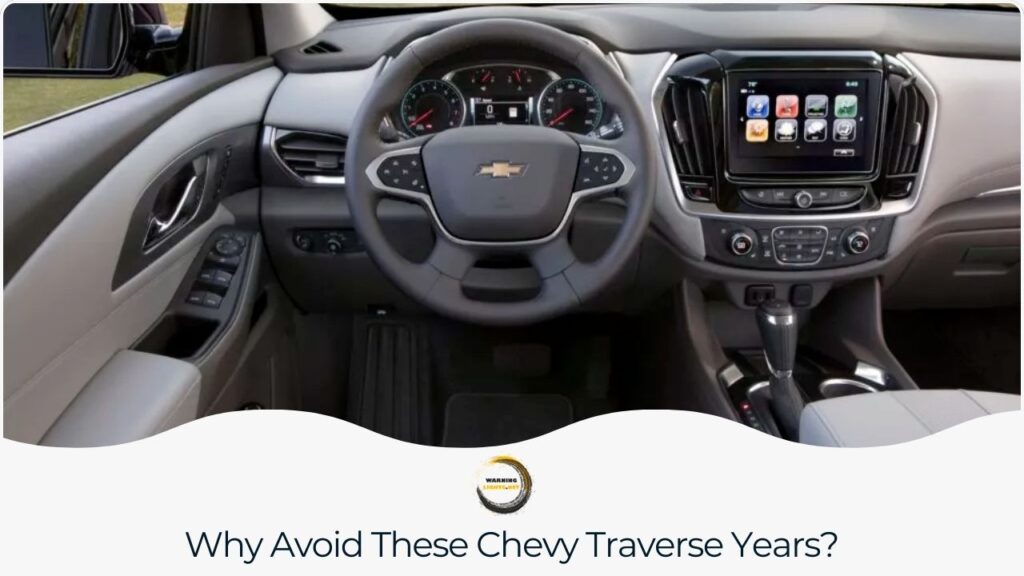Navigating the Chevrolet Traverse: Years to Consider and Avoid
Navigating the Chevrolet Traverse: Years to Consider and Avoid
Introduction
With great pleasure, we will explore the intriguing topic related to Navigating the Chevrolet Traverse: Years to Consider and Avoid. Let’s weave interesting information and offer fresh perspectives to the readers.
Table of Content
Navigating the Chevrolet Traverse: Years to Consider and Avoid

The Chevrolet Traverse, a mid-size SUV known for its spacious interior and family-friendly features, has been a popular choice for drivers seeking a reliable and comfortable vehicle. However, like any car, the Traverse has seen its share of model years that are more prone to issues than others. Understanding these potential pitfalls can help prospective buyers make informed decisions and avoid potential headaches down the road.
The First Generation (2009-2017): A Mixed Bag
The first generation of the Chevrolet Traverse, spanning from 2009 to 2017, introduced the model to the market and established its core attributes. While generally reliable, certain years within this generation have been identified as having more common problems.
2010 and 2011 Traverse: Early Issues
The initial years of production, 2010 and 2011, saw a higher frequency of reported issues, particularly concerning the transmission. Complaints included shuddering, slipping, and premature failure. Additionally, some owners encountered problems with the electrical system, including faulty sensors and wiring.
2013 Traverse: Transmission Troubles and Engine Concerns
The 2013 Traverse saw a resurgence of transmission issues, with owners reporting similar problems to those experienced in the 2010 and 2011 models. Furthermore, some owners reported issues with the engine, including misfires and excessive oil consumption.
2015 Traverse: A Relatively Smooth Year
While not entirely issue-free, the 2015 Traverse generally saw a decrease in reported problems compared to previous years. However, some owners still reported issues with the transmission and the electrical system.
2017 Traverse: A Farewell to the First Generation
The final year of the first generation, 2017, witnessed a significant redesign, introducing a more refined exterior and interior. However, some owners reported issues with the new infotainment system and the powertrain.
The Second Generation (2018-Present): A Newer Era
The second generation of the Chevrolet Traverse, launched in 2018, brought a complete overhaul, incorporating a new platform, updated styling, and enhanced technology. This generation has generally been lauded for its improved performance, fuel efficiency, and overall reliability.
2018 and 2019 Traverse: Initial Reliability Concerns
While the second generation introduced significant improvements, the early years of production, 2018 and 2019, saw some owners report issues with the infotainment system, the electrical system, and the engine.
2020 and 2021 Traverse: A Step Forward
The 2020 and 2021 Traverse models saw a decrease in reported issues compared to the previous years. However, some owners continued to report problems with the infotainment system and the electrical system.
2022 and 2023 Traverse: The Latest Models
The latest models, the 2022 and 2023 Traverse, have generally received positive reviews for their reliability and performance. However, it’s crucial to note that these models are relatively new, and long-term reliability data is still being collected.
Beyond Specific Years: Common Traverse Issues
While certain years may be more prone to specific problems, it’s important to understand that the Chevrolet Traverse, like any vehicle, can experience issues over time. Common problems that have been reported across various model years include:
- Transmission Problems: Transmission issues, such as shuddering, slipping, and premature failure, have been a recurring theme in the Traverse.
- Electrical System Problems: Faulty sensors, wiring issues, and problems with the infotainment system are common complaints.
- Engine Problems: Misfires, excessive oil consumption, and engine noise have been reported by some owners.
- Suspension Problems: Suspension issues, including squeaks, rattles, and premature wear, have been reported in certain models.
- Interior Issues: Some owners have reported issues with the interior, including faulty door handles, seat malfunctions, and problems with the climate control system.
Understanding the Importance of Thorough Research
When considering a Chevrolet Traverse, it’s crucial to conduct thorough research before making a decision. Researching specific model years, reading owner reviews, and consulting reputable sources like Consumer Reports can provide valuable insights into potential problems and help you make an informed choice.
FAQs: Chevrolet Traverse Model Years to Avoid
Q: Which Chevrolet Traverse model years are most likely to have problems?
A: The 2010, 2011, and 2013 Traverse models have been identified as having a higher frequency of reported issues, particularly related to the transmission, electrical system, and engine.
Q: What are the most common problems with the Chevrolet Traverse?
A: Common problems reported across various model years include transmission issues, electrical system problems, engine problems, suspension problems, and interior issues.
Q: Is the Chevrolet Traverse a reliable vehicle?
A: The Chevrolet Traverse is generally considered a reliable vehicle, especially in its second generation. However, certain model years have been known to have more problems than others.
Q: What should I look for when buying a used Chevrolet Traverse?
A: When buying a used Chevrolet Traverse, it’s essential to have the vehicle inspected by a qualified mechanic. Pay close attention to the condition of the transmission, electrical system, engine, suspension, and interior.
Tips for Choosing a Chevrolet Traverse
- Research specific model years: Thoroughly research the specific model years you are considering, paying attention to common problems and owner reviews.
- Get a pre-purchase inspection: Have a qualified mechanic inspect the vehicle before making a purchase to identify any potential issues.
- Check the vehicle history report: Obtain a vehicle history report from a reputable source like Carfax or AutoCheck to verify the vehicle’s maintenance history and any reported accidents.
- Consider certified pre-owned (CPO) models: CPO models often come with extended warranties and have undergone rigorous inspections, providing additional peace of mind.
- Negotiate the price: Be prepared to negotiate the price based on the vehicle’s condition, mileage, and any identified issues.
Conclusion: Navigating the Chevrolet Traverse Landscape
While the Chevrolet Traverse offers a compelling combination of space, comfort, and features, understanding the potential pitfalls of certain model years is crucial for making an informed decision. By conducting thorough research, paying attention to common problems, and seeking expert advice, prospective buyers can navigate the Traverse landscape and find a reliable and enjoyable vehicle that meets their needs.







Closure
Thus, we hope this article has provided valuable insights into Navigating the Chevrolet Traverse: Years to Consider and Avoid. We thank you for taking the time to read this article. See you in our next article!
